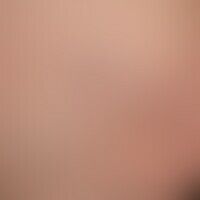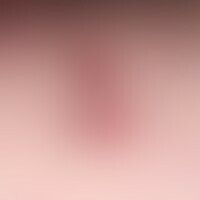Image diagnoses for "Leg/Foot"
404 results with 1180 images
Results forLeg/Foot

Necrobiosis lipoidica L92.1
Necrobiosis lipoidica: 2-year-old, solitary, chronically stationary, approx. 3.5 x 3.0 cm in size, localized on the left lower leg, blurredly limited, brown-reddish plaque with central atrophy.

Pagetoid reticulosis C84.4
Reticulosis, pagetoid (disseminated type Ketron and Goodman): For several years slowly migrating, partly anular, partly garland-shaped, little itchy, brown-red, only minimally elevated, broadly margined plaques with parchment-like surface.

Pityriasis lichenoides chronica L41.1
Pityriasis lichenoides chronica:moderately itchy, dense, maculo-papular exanthema that has been present for several months.

Erysipelas bullous
Erysipelas bullöses: acuteareal, sharply defined, painful reddening and plaque and areal blistering in the area of the lower leg. entry portal: macerated tinea pedum. fever, chills, lymphangitis and lymphadenitis also exist.

Primary cutaneous diffuse large cell b-cell lymphoma leg type C83.3
primary diffuse diffuse large cell B-cell lymphoma leg type: for about2 years papules and nodules on the left leg of a 55 years old woman appearing in relapses. in the last weeks rapid growth of the pre-existing nodules and eruptive appearance of new nodules. initially no symptoms. since 2 months increasing tendency to dry and also weeping surface scaling. in places complete decay of the nodules.

Sarcoidosis of the skin D86.3
Sarcoidosis, plaque form: slightly pressure-painful plaques of the skin with plates with a scaly surface that can be easily distinguished from the surrounding area and can be moved on the support.

Necrobiosis lipoidica L92.1
Necrobiosis lipoidica: Waxy, reddish-brown, smooth, shiny infiltrate plates with several punched-out ulcers (after banal trauma) in type I diabetes in the area of the tibia.

Pityriasis lichenoides (et varioliformis) acuta L41.0
Pityriasis lichenoides et varioliformis acuta. 15-month-oldchild. 0.2-0.4 cm large, symmetrically arranged, only slightly itchy, red, surface-smooth and eroded papules and papulovesicles disseminated on the trunk and extremities for a few days.

Squamous cell carcinoma of the skin C44.-
Squamous cell carcinoma of the skin: ulcerated, spinocellular carcinoma of the lower leg, which has long been misunderstood as an ulcer (cruris) and thus has been treated unsuccessfully. Remarkable: Only slight pain!

Primary cutaneous diffuse large cell b-cell lymphoma leg type C83.3
Primary cutaneous diffuse large cell B-cell lymphoma leg type: For about 2 years papules and nodules on the left leg of a 55 years old woman appearing in relapses. In the last weeks rapid growth of the pre-existing nodules and eruptive appearance of new ones. Initially no symptoms. For 2 months increasing tendency to surface scaling and ulcer formation.

Lipedema R60.9
Lipedema: bilateral, initially painless, and after years of existence painful, symmetrical, initially discrete, later increasing, partly jodhpur-like fatty degeneration of the legs. the circumference of the thigh is disproportionately enlarged in comparison to the relatively slim upper body. back of the foot and toes are not swollen (Stemmersch's sign: negative). tendency tohaematomas

Nummular dermatitis L30.0
Nummular dermatitis: chronically active, for several months existing, approx. 6 cm large, raised, partly eroded, partly crusty plaques in a 45-year-old man. The surrounding skin is reddened.

Melanoma nodular C43.L
Melanoma, malignant, nodular: Rapid growth in thickness in the last few months "I have already wet and bled once" (see further explanation in the following figure)

Vascular malformations Q28.88
Malformation, vascular: venousmalformation with circumscribed, painless soft tissue swelling (circled); ectatic subcutaneous veins.

Infant haemangioma (overview) D18.01

Carcinoma cuniculatum C44.L5
Carcinoma cuniculatum: Advanced verrucous carcinoma of the sole of the foot (here heel region), which has existed in its early stages for >2 years. No significant pain symptoms. No regional lymph node metastases detectable.

Varice reticular I83.91
Spider veins: Dark blue-red, 0.5-1.0 mm thick, tortuous dilated venules with irregular, ampulla or nodular ectasia on the medial left thigh of a 69-year-old woman.







